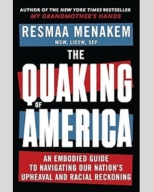This past week, which marked the annual State of the Union address by the president, politicians on both sides of the aisle demonstrated the political power of fear.
Fear is an excellent communicator, to whom everyone listens. And fear is not always a bad thing: It can communicate information we need to know. It is a basic human emotion.
But because of this, people often use fear to manipulate others, and it’s crucial that we identify when this is happening. Writer and activist Sonya Renee Taylor talks about being “fear-facing”: “I learn how to listen to my body,” she writes. “I must listen or I will die. … I must learn the difference between fear and danger.”
Politicians selling fear for votes are hoping we will not make a distinction between fear, which may be baseless, and danger, which is present and real. The rhetoric of fear only works if, instead of discerning, we react: fight, flight, freeze, annihilate.
In political terms, those reactions often include othering, dehumanization, demonization, isolation, and polarization; as therapist Resmaa Menakem notes, these in turn “stoke ever more fury, fear, and mistrust among voters — and . . . encourage people to turn on each other.” They “destroy any shared sense of public good, truth, facts, or reality, both in relation to American elections and in general.”
When we get to the point where fear is a commander, not a communicator, we have entered dangerous territory. Fear and danger provide solid rock for fascism (and other absolute power-grabs) and shifting sand for a democracy. Consider this statistic: “In 2021, the Brennan Center for Justice reported that a third of all US election officials felt unsafe in their jobs — and that one in six had received threats.”
To reestablish democracy on solid rock, and work towards what Menakem calls a “pro-Democracy body,” try these practices that nurture a proper relationship to fear.
 Experience a Recent Fear in a Calm, Private Moment: In The Quaking of America, Menakem recommends taking time to become familiar with how your body responds to fear:
Experience a Recent Fear in a Calm, Private Moment: In The Quaking of America, Menakem recommends taking time to become familiar with how your body responds to fear:
“[R]ecall a recent incident in which you freaked out and spun into a fight or flee or annihilate response. Relive that incident in your body and mind. What created the stresses or conflict? What did your body experience as the stress mounted? Did you sense yourself getting close to your edge? How did this awareness show up in your body?
“What happened that finally pushed you over that edge? What did your body experience as you went over it? What did you say and/or do as you freaked out? What happened after that?
“What did you eventually do that enabled your body to begin to settle? What, if anything, did anyone else do to help you settle?”
Keep a Fear Journal: In a similarly calm moment, journal the sensations associated with each stage of your response to fear. For help with how to journal bodily sensations, read about the body’s six intelligences.
Main Image (A 2016 protest against then-President Trump's ban on immigrants from majority Muslim countries) Source: By Kenneth Lu from San Francisco, CA - SFO #noban Protest -Jan 29, 2016, CC BY 2.0
